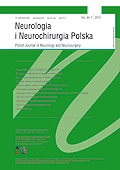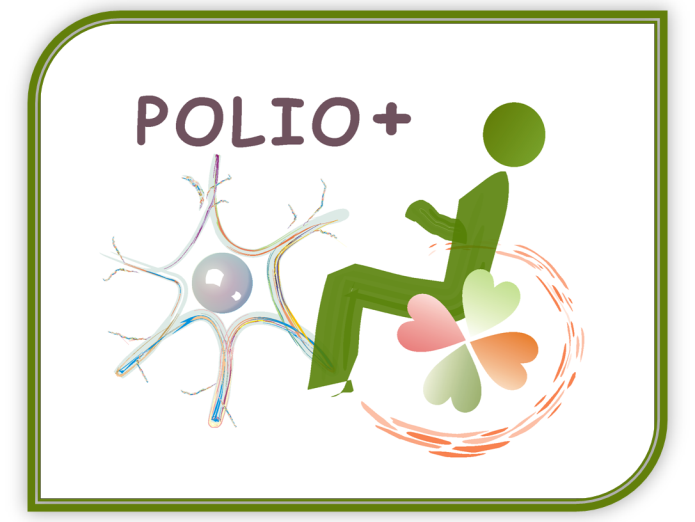 Zespół post-polio
Zespół post-polio
Część II. Postępowanie terapeutyczne
Ewa Matyja
prof. dr hab. Ewa Matyja – Zakład Neuropatologii, Instytut Medycyny Doświadczalnej i Klinicznej im. M. Mossakowskiego Polskiej Akademii Nauk,
ul. Pawińskiego 5, 02-106 Warszawa
ematyja@imdik.pan.pl
Neurologia i Neurochirurgia Polska 2012; 46, 4: 357-371
Artykuł zamieszczony w porozumieniu z Autorką, za zgodą Redakcji Czasopisma „Neurologia i Neurochirurgia Polska” oraz Wydawnictwa Termedia.
Bibliografia
- Farbu E., Gilhus N.E., Barnes M.P. i wsp. EFNS guideline on diagnosis and management of post-polio syndrome. Report of an EFNS task force. Eur J Neurol 2006; 13: 795-801.
- Bruno R.L. Post-polio sequelae: research and treatment in the second decade. Orthopedics 1991; 14: 1169-1170.
- Boyer F.C., Tiffreau V., Rapin A. i wsp. Post-polio syndrome: pathophysiological hypotheses, diagnosis criteria, drug therapy. Ann Phys Rehabil Med 2010; 53: 34-41.
- Farbu E. Update on current and emerging treatment options for post-polio syndrome. Ther Clin Risk Manag 2010; 6: 307-313.
- Bartels M.N., Omura A. Aging in polio. Phys Med Rehabil Clin N Am 2005; 16: 197-218.
- Gonzalez H., Olsson T., Borg K. Management of postpolio syndrome. Lancet Neurol 2010; 9: 634-642.
- Dalakas M.C. How to design a therapeutic study in patients with the post-polio syndrome. Methodological concerns and status of present therapies. Ann N Y Acad Sci 1995; 753: 314-320.
- Jubelt B. Post-polio syndrome. Curr Treat Options Neurol 2004; 6: 87-93.
- Jubelt B., Agre J.C. Characteristics and management of postpolio syndrome. JAMA 2000; 284: 412-414.
- Nollet F., Beelen A., Twisk J.W. i wsp. Perceived health and physical functioning in postpoliomyelitis syndrome: a 6-year prospective follow-up study. Arch Phys Med Rehabil 2003; 84: 1048-1056.
- Elrod L.M., Jabben M., Oswald G. i wsp. Vocational implications of post-polio syndrome. Work 2005; 25: 155-161.
- Dean E. Clinical decision making in the management of the late sequelae of poliomyelitis. Phys Ther 1991; 71: 752-761.
- Halstead L.S. Post-polio syndrome. Sci Am 1998; 278: 42-47.
- Aston J.W., Jr. Post-polio syndrome. An emerging threat to polio survivors. Postgrad Med 1992; 92: 249-256, 260.
- Packer T.L., Martins I., Krefting L. i wsp. Activity and post-polio fatigue. Orthopedics 1991; 14: 1223-1226.
- Bruno R.L. The Ten Commandments of PPS. New Mobility. Post-Polio Institute and International Centre for Post-Polio Education and Research, http://www.postpolioinfo.com/library/tencom.pdf.
- Rekand T., Korv J., Farbu E. i wsp. Lifestyle and late effects after poliomyelitis. A risk factor study of two populations. Acta Neurol Scand 2004; 109: 120-125.
- Bruno R.L., Cohen J.M., Galski T. i wsp. The neuroanatomy of post-polio fatigue. Arch Phys Med Rehabil 1994; 75: 498-504.
- Grimby G., Jonsson A.L. Disability in poliomyelitis sequelae. Phys Ther 1994; 74: 415-424.
- Bertelsen M., Broberg S., Madsen E. Outcome of physiotherapy as part of a multidisciplinary rehabilitation in an unselected polio population with one-year follow-up: an uncontrolled study. J Rehabil Med 2009; 41: 85-87.
- Perry J., Barnes G., Gronley J.K. The postpolio syndrome. An overuse phenomenon. Clin Orthop Relat Res 1988; 145-162.
- Borg K., Borg J., Dhoot G. i wsp. Motoneuron firing and isomyosin type of muscle fibres in prior polio. J Neurol Neurosurg Psychiatry 1989; 52: 1141-1148.
- Agre J.C. The role of exercise in the patient with post-polio syndrome. Ann N Y Acad Sci 1995; 753: 321-334.
- Tiffreau V., Rapin A., Serafi R. i wsp. Post-polio syndrome and rehabilitation. Ann Phys Rehabil Med 2010; 53: 42-50.
- Chan K.M., Amirjani N., Sumrain M. i wsp. Randomized controlled trial of strength training in post-polio patients. Muscle Nerve 2003; 27: 332-338.
- Agre J.C., Rodriquez A.A., Franke T.M. Strength, endurance, and work capacity after muscle strengthening exercise in postpolio subjects. Arch Phys Med Rehabil 1997; 78: 681-686.
- Einarsson G. Muscle conditioning in late poliomyelitis. Arch Phys Med Rehabil 1991; 72: 11-14.
- Ernstoff B., Wetterqvist H., Kvist H. i wsp. Endurance training effect on individuals with postpoliomyelitis. Arch Phys Med Rehabil 1996; 77: 843-848.
- Owen R.R., Jones D. Polio residuals clinic: conditioning exercise program. Orthopedics 1985; 8: 882-883.
- Spector S.A., Gordon P.L., Yildiz E. i wsp. Effect of strength training in patients with post-polio syndrome. A preliminary report. Ann N Y Acad Sci 1995; 753: 402-404.
- Hildegunn L., Jones K., Grenstad T. i wsp. Perceived disability, fatigue, pain and measured isometric muscle strength in patients with post-polio symptoms. Physiother Res Int 2007; 12: 39-49.
- Feldman R.M., Soskolne C.L. The use of nonfatiguing strengthening exercises in post-polio syndrome. Birth Defects Orig Artic Ser 1987; 23: 335-341.
- Einarsson G., Grimby G. Strengthening exercise program in post-polio subjects. Birth Defects Orig Artic Ser 1987; 23: 275-283.
- Fillyaw M.J., Badger G.J., Goodwin G.D. i wsp. The effects of long-term non-fatiguing resistance exercise in subjects with post-polio syndrome. Orthopedics 1991; 14: 1253-1256.
- Nollet F., Beelen A., Sargeant A.J. i wsp. Submaximal exercise capacity and maximal power output in polio subjects. Arch Phys Med Rehabil 2001; 82: 1678-1685.
- Brehm M.A., Nollet F., Harlaar J. Energy demands of walking in persons with postpoliomyelitis syndrome: relationship with muscle strength and reproducibility. Arch Phys Med Rehabil 2006; 87: 136-140.
- Davidson A.C., Auyeung V., Luff R. i wsp. Prolonged benefit in post-polio syndrome from comprehensive rehabilitation: a pilot study. Disabil Rehabil 2009; 31: 309-317.
- Strumse Y.A., Stanghelle J.K., Utne L. i wsp. Treatment of patients with postpolio syndrome in a warm climate. Disabil Rehabil 2003; 25: 77-84.
- Willen C., Sunnerhagen K.S., Grimby G. Dynamic water exercise in individuals with late poliomyelitis. Arch Phys Med Rehabil 2001; 82: 66-72.
- Milner-Brown H.S. Muscle strengthening in a post-polio subject through a high-resistance weight-training program. Arch Phys Med Rehabil 1993; 74: 1165-1167.
- Oncu J., Durmaz B., Karapolat H. Short-term effects of aerobic exercise on functional capacity, fatigue, and quality of life in patients with post-polio syndrome. Clin Rehabil 2009; 23: 155-163.
- Dean E., Ross J. Effect of modified aerobic training on movement energetics in polio survivors. Orthopedics 1991; 14: 1243-1246.
- Heim M., Yaacobi E., Azaria M. A pilot study to determine the efficiency of lightweight carbon fibre orthoses in the management of patients suffering from post-poliomyelitis syndrome. Clin Rehabil 1997; 11: 302-305.
- Brehm M.A., Beelen A., Doorenbosch C.A. i wsp. Effect of carbon-composite knee-ankle-foot orthoses on walking efficiency and gait in former polio patients. J Rehabil Med 2007; 39: 651-657.
- Klefbeck B., Lagerstrand L., Mattsson E. Inspiratory muscle training in patients with prior polio who use part-time assisted ventilation. Arch Phys Med Rehabil 2000; 81: 1065-1071.
- Weinberg J., Borg J., Bevegard S. i wsp. Respiratory response to exercise in postpolio patients with severe inspiratory muscle dysfunction. Arch Phys Med Rehabil 1999; 80: 1095-1100.
- Gillis-Haegerstrand C., Markstrom A., Barle H. Bi-level positive airway pressure ventilation maintains adequate ventilation in post-polio patients with respiratory failure. Acta Anaesthesiol Scand 2006; 50: 580-585.
- Bach J.R. Management of post-polio respiratory sequelae. Ann N Y Acad Sci 1995; 753: 96-102.
- Abaza M.M., Sataloff R.T., Hawkshaw M.J. i wsp. Laryngeal manifestations of postpoliomyelitis syndrome. J Voice 2001; 15: 291-294.
- Sonies B.C., Dalakas M.C. Dysphagia in patients with the post-polio syndrome. N Engl J Med 1991; 324: 1162-1167.
- Soderholm S., Lehtinen A., Valtonen K. i wsp. Dysphagia and dysphonia among persons with post-polio syndrome – a challenge in neurorehabilitation. Acta Neurol Scand 2010; 122: 343-349.
- Sonies B.C. Dysphagia and post-polio syndrome: past, present, and future. Semin Neurol 1996; 16: 365-370.
- Sonies B.C., Dalakas M.C. Progression of oral-motor and swallowing symptoms in the post-polio syndrome. Ann N Y Acad Sci 1995; 753: 87-95.
- Vasconcelos O.M., Prokhorenko O.A., Salajegheh M.K. i wsp. Modafinil for treatment of fatigue in post-polio syndrome: a randomized controlled trial. Neurology 2007; 68: 1680-1686.
- Horemans H.L., Nollet F., Beelen A. i wsp. Pyridostigmine in postpolio syndrome: no decline in fatigue and limited functional improvement. J Neurol Neurosurg Psychiatry 2003; 74: 1655-1661.
- Trojan D.A., Collet J.P., Shapiro S. i wsp. A multicenter, randomized, double-blinded trial of pyridostigmine in postpolio syndrome. Neurology 1999; 53: 1225-1233.
- Nollet F., Horemans H., Beelen A. A multicenter, randomized, double-blinded trial of pyridostigmine in postpolio syndrome. Neurology 2000; 55: 899-901.
- On A.Y., Oncu J., Uludag B. i wsp. Effects of lamotrigine on the symptoms and life qualities of patients with post polio syndrome: a randomized, controlled study. NeuroRehabilitation 2005; 20: 245-251.
- Dinsmore S., Dambrosia J., Dalakas M.C. A double-blind, placebo-controlled trial of high-dose prednisone for the treatment of post-poliomyelitis syndrome. Ann N Y Acad Sci 1995; 753: 303-313.
- Stein D.P., Dambrosia J.M., Dalakas M.C. A double-blind, placebo-controlled trial of amantadine for the treatment of fatigue in patients with the post-polio syndrome. Ann N Y Acad Sci 1995; 753: 296-302.
- Mizuno M., Quistorff B., Theorell H. i wsp. Effects of oral supplementation of coenzyme Q10 on 31P-NMR detected skeletal muscle energy metabolism in middle-aged post-polio subjects and normal volunteers. Mol Aspects Med 1997; 18 (supl.): S291-298.
- Skough K., Krossen C., Heiwe S. i wsp. Effects of resistance training in combination with coenzyme Q10 supplementation in patients with post-polio: a pilot study. J Rehabil Med 2008; 40: 773-775.
- Bruno R.L., Zimmerman J.R., Creange S.J. i wsp. Bromocriptine in the treatment of post-polio fatigue: a pilot study with implications for the pathophysiology of fatigue. Am J Phys Med Rehabil 1996; 75: 340-347.
- Trojan D.A., Cashman N.R. Fibromyalgia is common in a postpoliomyelitis clinic. Arch Neurol 1995; 52: 620-624.
- Farbu E., Rekand T., Vik-Mo E. i wsp. Post-polio syndrome patients treated with intravenous immunoglobulin: a double-blinded randomized controlled pilot study. Eur J Neurol 2007; 14: 60-65.
- Kaponides G., Gonzalez H., Olsson T. i wsp. Effect of intravenous immunoglobulin in patients with post-polio syndrome – an uncontrolled pilot study. J Rehabil Med 2006; 38: 138-140.
- Gonzalez H., Ottervald J., Nilsson K.C. i wsp. Identification of novel candidate protein biomarkers for the post-polio syndrome – implications for diagnosis, neurodegeneration and neuroinflammation. J Proteomics 2009; 71: 670-681.
- Dalakas M.C. Role of IVIg in autoimmune, neuroinflammatory and neurodegenerative disorders of the central nervous system: present and future prospects. J Neurol 2006; 253 Suppl 5: V25-V32.
- Gonzalez H., Sunnerhagen K.S., Sjoberg I. i wsp. Intravenous immunoglobulin for post-polio syndrome: a randomised controlled trial. Lancet Neurol 2006; 5: 493-500.
- Haziza M., Kremer R., Benedetti A. i wsp. Osteoporosis in a postpolio clinic population. Arch Phys Med Rehabil 2007; 88: 1030-1035.
- Mohammad A.F., Khan K.A., Galvin L. i wsp. High incidence of osteoporosis and fractures in an aging post-polio population. Eur Neurol 2009; 62: 369-374.
- Alvarez A., Kremer R., Weiss D.R. i wsp. Response of postpoliomyelitis patients to bisphosphonate treatment. PM R 2010; 2: 1094-1103.
- Hollingsworth L., Didelot M.J., Levington C. Post-polio syndrome: psychological adjustment to disability. Issues Ment Health Nurs 2002; 23: 135-156.
- Bruno R.L., Frick N.M. The psychology of polio as prelude to post-polio sequelae: behavior modification and psychotherapy. Orthopedics 1991; 14: 1185-1193.
- Bruno R.L. Preventing complications in polio survivors undergoing surgery. PPS Monograph Series. Volume 6(2). Harvest Press, Hackensack 1996.
- Bruno R.L., Sapolsky R., Zimmerman J.R. i wsp. Pathophysiology of a central cause of post-polio fatigue. Ann N Y Acad Sci 1995; 753: 257-275.
- Bordes J., Gaillard P.E., Lacroix G. i wsp. Spinal anaesthesia guided by computed tomography scan in a patient with severe post-polio sequelae. Br J Anaesth 2010; 105: 702-703.

